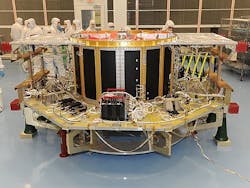VPX embedded computing standard tailored for space applications ratified by ANSI and VITA
The VITA 78 SpaceVPX Systems standard capitalizes on the OpenVPX standards family, and has been ratified by the VITA Open Systems and Open Markets trade group in Fountain Hills, Ariz., as well as the American National Standards Institute (ANSI).
The ANSI/VITA 78.00-2015 specification has completed the VITA and ANSI processes reaching full recognition under guidance of the VITA Standards Organization (VSO).
SpaceVPX Systems seeks to achieve an acceptable level of fault tolerance while maintaining reasonable compatibility with OpenVPX components, including connector pin assignments.
SpaceVPX seeks to create standard electronic architectures for satellites and manned spacecraft in an effort to reduce costs and ease systems upgrades and technology insertion.
Related: Industry and government attack costs and promote reuse in space electronics with VITA 78
The standard defines standard interfaces, data paths, connectors, and other building blocks for space electronics, which historically have been custom legacy designs that are difficult and expensive to replicate and upgrade.
Legacy space systems often are point solutions with proprietary and application-specific internal interfaces, where re-use is not a priority, says Patrick Collier, senior electrical research engineer and deputy program manager at the Air Force Research Laboratory at Kirtland Air Force Base, N.M., and chairman of the VITA 78 Working Group.
Today's legacy space electronic designs typically use modules that are not designed to interoperate either at the hardware of software level. One of the biggest problems with today's legacy space electronics designs is the prime contractor has a central role for the life of the system, which limits flexibility and options, and stifles competition.
VITA 78 SpaceVPX, instead, seeks to use open-systems architecture guidelines and open standards to achieve loose coupling between software and hardware in space electronics designs.
Related: NRL chooses 3U VPX embedded computing from 4DSP for maritime and space research
SpaceVPX is intended to reduce risks and costs tied to reintegration of interfaces to make software and hardware reuse more attractive and affordable. Use of industry-consensus interfaces will provide more vendor based options from a broader market, with more regular sustained competition.
VITA 78 SpaceVPX is related to the OpenVPX embedded computing industry standards, but considers the special needs of space like radiation hardness, extreme reliability, and the ability to operate for prolonged periods in harsh operating conditions not found on land, sea, or in the air.
The standard defines payload, switch, controller, and backplane module profiles to meet the needs of space applications, and adds features to the utility plane for fault tolerance. Space VPX calls out point-to-point data paths, not bused paths, to help space systems tolerate faults and avoid module failures that affect the entire system.
SpaceVPX adds a space utility module to provide a dual-redundant source for utility plane implementations, and defines use of the IEEE 1355-based SpaceWire spacecraft communications network standard for control plane over Ethernet.
Related: VPX rugged embedded computing market set to exceed venerable VME by 2017, analyst says
The SpaceVPX standard seeks to maintain reasonable compatibility with OpenVPX components such as connector pin assignments to help promote interoperability and vendor choice in space electronic designs, speed development and deployment time, offer relatively high board volumes for economies of scale, and encourage a high velocity of space technology upgrades, Collier says.
NASA is evaluating 6U and 3U SpaceVPX form factors, and prototype products should be available by next fall or winter. For high reliability applications, the major fault tolerance requirements are:
-- dual-redundant power distribution (bused) where each distribution is supplied from an independent power source;
-- dual-redundant utility plane signal distribution (point-to-point cross-strapped) where each distribution is supplied from an independent system controller to a module that selects between the a and b system controllers for distribution to each of the slots controlled by the module;
-- card-level serial management;
-- card-level reset control;
-- card-level power control;
-- matched length, low-skew differential timing/synchronization/clocks;
-- fault-tolerant power supply select (bused);
-- fault-tolerant system controller signal selection (bused);
-- dual-redundant data planes (point-to-point cross-strapped);
-- dual-redundant control planes (point-to-point cross-strapped); and
-- each module is a managed field replaceable unit as defined by VITA 46.11.
Related: VPX emerging as the industry choice for high-performance embedded computing
Those interested can buy copies of the VITA 78 SpaceVPX specification for $100 online at http://shop.vita.com/searchquick-submit.sc?keywords=SpaceVPX.
For additional information contact VITA online at www.vita.com.
